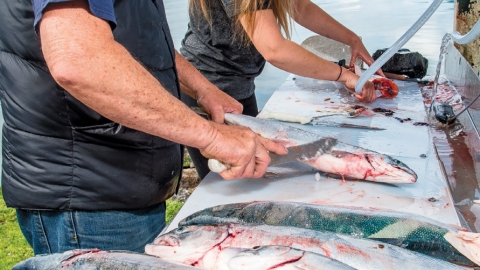Where the river meets the road
Each spring as the snow begins to shrink, I drive out the Copper River Highway in search of edible greens. The first young fireweed shoots and fiddleheads emerge during the growing daylight of late April and May. All along the road edges, I see these olivine gems spring up where the wild beautiful chaos of the wilderness meets the flat gravel. Over the summer, I will drive this stretch many times—to campfires with friends, and fishing holes, and hikes. This year, as I traversed this familiar stretch of easy foraging ground, I couldn’t help but think of the paradox of this road—both barrier and bastion for wild foods and those who rely on them.
The Copper River Highway juts through this delta wetland in a 36-mile-long route that runs west to east. It is the only large highway in the region and connects residents to an essential airport, national forest, and Native lands.
The Copper River Delta is the largest contiguous wetland in North America. It is home to migrating birds, wild salmon, and mammals of all sizes, including people. The delta is a system of small rivers and sloughs which wind their way down in dizzying braids from glacial headwaters in the Wrangell Mountains into the Gulf of Alaska. While this part of the river system is large, it is only a small fraction of the entire watershed. Huge swaths of it, which in total is about the size of West Virginia, are remote. Cordova’s Copper River Highway, near the mouth of the delta, is one of the places where people and the river converge.
As wild king, sockeye, and coho salmon begin their journey upriver to spawn, they enter the delta ecosystem. This is but the very beginning of a long and physically demanding journey up the Copper River. All along the way these fish play a keystone role in the watershed. Wild Copper River salmon support the economy and culture of Cordova as they are commercially harvested where the delta meets the ocean. Then, in the river system, they continue to be food for recreational and subsistence fishermen as well as some 100 other different animal species. Wild salmon bring marine nitrogen and phosphorus within themselves far into the watershed’s upper reaches. When the fish die and decay, these nutrients spread into the soil and help the spruce and hemlock forests thrive. Considering some fish will swim 300 miles to reach their final spawning grounds, their impact on the overall watershed’s vitality is exponential.
The Copper River Highway juts through this delta wetland in a 36-mile-long route that runs west to east. It is the only large highway in the region and connects residents to an essential airport, national forest, and Native lands. Like many communities disconnected from the larger road system throughout Alaska, Cordova, as a community, both embraces and endures its isolation. Much of the challenge and opportunity from living remote comes in the form of food. Grocery store prices in rural Alaska can be shocking; produce can be travel weary. But the land around the highway is full of mushrooms, berries, wild greens, and edible flowers. The streams over which the highway runs teem with fatty Copper River salmon, and the riverbanks are alive with ducks and geese. In this way, the highway is an essential lifeline between people and accessible wild food foraging. It also serves as one of the primary connections to enjoying the outdoors, whether it be hiking trails, boat launches, cross country skiing or birdwatching. On any given day in all seasons, Cordovans can be seen driving out the highway in search of fun and forage, an activity collectively called “going out the road.” However, while the road offers a cultural lifeline for residents, it also can act as a giant dyke which fragments the wetland ecosystem and cuts through wild salmon spawning passageways.
The Copper River Highway can be a major barrier for fish. A few critical bridges help salmon pass easily under the road in some places but in others, small culvert pipes present a significant challenge for the fish. A typical highway culvert has a round bottom which constricts the space through which a fish may swim. Culverts may also become damaged over time and suffer from debris blockages and sedimentation. All these factors represent significant obstacles that may prevent some wild salmon from fully connecting to their role in the watershed ecosystem. For a place that provides so much, we should be compelled to ask what more we can give back.
The Copper River Watershed Project (CRWP) is a nonprofit that works to support healthy ecosystems. The organization has created a fish passage program, part of which replaces old culverts with larger, wider pipes. These fish-friendly culverts feature flat bottoms to allow water to flow freely and easily throughout. Once placed, streambed material is situated inside of the culvert and the bank along its sides restored with native plants so that each fish may pass underneath the highway surrounded by a natural environment. CRWP began replacing culverts along the highway in 2008 after identifying high priority stream passage areas that needed restorative attention. For the last three years, the organization has invested over $8.7 million in the fish passage programs directly impacting watershed health. Much of this funding has come from recent federal infrastructure bills, but plenty has been made available through fundraising amongst residents throughout the watershed as well. As of 2023, the organization will have reconstructed 18 high priority crossing sites throughout the watershed, totaling 82 miles of reconnected salmon habitat.
The idea of regenerative tourism has taken hold in coastal Alaska recently. The term is borrowed from regenerative agriculture and promotes the idea that a place can be left better than one originally found it through volunteering or supporting sustainable local business. But regenerative activities can come from within a community as well, not just through visitors. What does it mean to apply regenerative practices to wild spaces? How does that mirror or differ from the stewardship of Alaska Native people, including the Eyak who were the original stewards of the Copper River’s salmon on the delta? Indigenous values support mutually beneficial ecological relationships as well as the acknowledgement that food from nature is much more than just food.
Efforts like the culvert replacement project and stream restoration along the Copper River Delta can help us rethink what it means to live with nature in a modern world. Many people use and enjoy the delta ecosystem as a food and cultural resource. Restorative, future-facing infrastructure aims not to prevent use, but rather to support a practice around it that leaves less negative impact. This work shows how human design has the potential to affect the landscape around us in ways that imbue it with meaning. If we design and build our infrastructure in a way that asks what we can give back to a place that gives us so much, we can unsettle the idea that only places untouched by people can be considered pristine.









